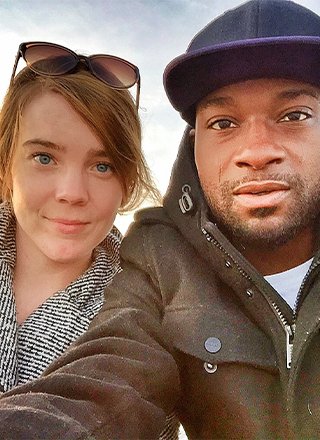By Kim Callinan
“He shouldn’t have suffered that way at the end. He was in so much pain. Nobody would listen. How could that happen in a civilized society?” Amanda sobbed to me. After consoling her, I asked where her husband had gotten his care. Her answer did not surprise me – he was being treated at a religious hospital.
The wall of separation between church and state within the health care arena is dubious at best. When it comes to end-of-life health care, that wall has all but crumbled away. Our public policies favor one interpretation of religion over another. Hospital policies dictate and limit the care patients receive, and as a result, far too many people are needlessly suffering as they near the end of their lives.
One stark example is when patients seek the option of medical aid in dying, which is what Amanda’s husband wanted. Medical aid in dying (sometimes referred to as “death with dignity”) allows a mentally capable, terminally ill adult with six months or less to live the option to request a doctor’s prescription for medication they can decide to take to die gently if their suffering becomes too great. The option of medical aid in dying is important because it establishes that patients have autonomy over their end-of-life care decisions. Unfortunately, the lack of separation between church and state makes that option not accessible to all individuals who need it.
National polling shows more than seven in 10 Americans support the option of medical aid in dying. Lawmakers are beginning to respond to their constituents’ demands for this peaceful option. The increased support is seen in recent legislative victories. While it took 20 years to authorize medical aid in dying in the first four states (Oregon, 1994; Washington, 2008; Montana, 2009; Vermont, 2013), it took just five years to authorize the practice in the six most recent jurisdictions (California, 2015; Colorado, 2016; Washington, D.C., 2017; Hawaii, 2018; New Jersey, 2019; Maine, 2019).
These recent legislative successes advancing medical aid in dying are promising. Yet four out of five Americans still lack an explicit legal right to medical aid in dying – largely because religion is dictating our public policy. In most, if not all, states, the largest, most organized and well-funded obstacle to the authorization of medical aid in dying is the Catholic Church. Medical aid in dying is only one example of how a religion’s health care system’s values could interfere with your end-of-life care.
U.S. Catholic health care is the nation’s largest group of not-for-profit health care providers, with over 21 million emergency-room visits annually, 668 hospitals and 1,668 continuing care facilities. Catholic health care is governed by Ethical and Religious Directives (ERDs), which are enforced by the U.S. Conference of Catholic Bishops. These directives dictate the kind of care a person can receive. As an example, if you are receiving care in a Catholic health care facility at life’s end:
• Your documented preference to forgo medically assisted nutrition or hydration will likely be ignored if you have dementia, which could result in the artificial extension of your life long beyond your documented desire or the time natural death would occur.
• It may be difficult for your health care proxy to honor your desire to remove a feeding tube or other form of life support, even if you are in a persistent vegetative state and have clearly documented preferences stating otherwise.
• Your doctor’s only option is to help you “appreciate the Christian understanding of redemptive suffering” if your pain is uncontrollable, rather than honoring your request for medical aid in dying. In some cases, your request for additional pain medication may even be denied.
The Catholic directives pertaining to end-of-life care are out of step with what most Americans want. A public opinion survey conducted by the Kaiser Family Foundation found that the majority of Americans (71%) would prioritize “helping people die without pain, discomfort or stress” over “preventing death and prolonging life.” Similarly, a 2019 study published in the Journal of the American Medical Association found that most Americans (71%) believe their personal choices about their health should take priority over a facility’s religious values. However, just 6% of Americans take religious affiliation into consideration when choosing where to receive their health care.
The problem is exacerbated because most Catholic health care systems don’t publicly disclose their policies. A New York Times analysis of Catholic hospital websites found the majority of them don’t disclose the care services they don’t offer for religious reasons. In fact, it was difficult to even tell the majority of the hospitals were Catholic.
When individuals request medical aid in dying, some Catholic health care institutions forbid their providers from even referring patients to an alternative provider. Fewer still allow their providers to counsel patients on the full breadth of their end-of-life care options, leaving patients without adequate information to make informed health care decisions. Such practices harm the ability of providers to deliver quality care, while robbing patients of the information necessary to make fully informed decisions.
A report recently published by Community Catalyst, “Bigger and Bigger: The Growth of Catholic Health Systems,” found that the number of Catholic-affiliated hospitals grew by more than 28% over the last two decades, while the number of secular hospitals dropped by nearly 14%. In states where medical aid in dying is authorized, it can often be difficult for patients to find providers willing to honor their request. The situation is exacerbated when patients unknowingly begin their care within a Catholic system and are not provided honest information about what services are and are not offered. Sometimes it’s too late to seek care elsewhere. This is particularly problematic in rural areas where sometimes the only care available within a 200+-mile radius is a Catholic-affiliated option.
Despite the fact that religious entities are allowed to dictate the kind of care they provide to patients, they remain eligible to receive millions of dollars in federal funding. According to the Community Catalyst report, Catholic hospitals and health systems receive nearly $48 billion of taxpayer dollars each year in the form of Medicare and Medicaid reimbursements. In contrast, health care providers that want to honor their patients’ preference for medical aid in dying may not bill Medicare, Medicaid or any federal program as a result of the Assisted Suicide Funding Restriction Act of 1997. This discriminatory policy hurts underserved communities and older adults most, many of whom rely on federal programs like Medicare for their health coverage.
Despite our already lopsided end-of-life care policies, efforts to impose religious edicts on patients persist. In 2018, the U.S. Department of Health and Human Services issued a new rule, Protecting Statutory Conscience Rights in Health Care, that, if enacted, would turbo-charge the imposition of religious values on the care we receive. As one example, under this rule, a provider could refuse on moral grounds to transfer a patient’s medical record to a new provider, leaving the patient without the ability to get timely care from another doctor. Our taxpayer dollars would then be used to protect the rights of the provider.
Fortunately, the implementation of the rule was temporarily halted last year as a result of a constitutional challenge. (Editor’s note: Americans United was among the organizations that filed the successful lawsuit.) I ardently hope President Joe Biden will revoke the rule. However, despite this best-case scenario, we can expect to see the issue brought forward in court cases for years to come. It will take some creative litigation to protect patients’ rights, given the newly constituted U.S. Supreme Court.
To maximize your freedom over your end-of-life care, I encourage you to do three things:
• Join advocacy efforts to protect and expand your end-of-life options by going to the “Take Action” section of the Compassion & Choices website: compassionandchoices.org/take action.
• Identify a local hospital near you that is not governed by ethical or religious directives that are in conflict with your values if possible, and make sure your loved ones know where to take you in an event of an emergency.
• Interview your doctor(s) to confirm that they will honor your preferences at life’s end by following the steps in our “Finding a Partner Doctor fact sheet” (available on our site).
When it comes to end-of-life care, current policies favor the rights of religious institutions over patients’ rights. While we have made considerable progress authorizing and implementing medical aid-in-dying laws in new states, challenges persist. It will take continued, persistent efforts to ensure that people are able to make their own end-of-life care decisions based on their conscience – free from interference by religiously affiliated health care entities.
Kim Callinan is president and CEO of Compassion & Choices, the nation’s oldest, largest and most active nonprofit working to improve and expand health care options for the end of life.


